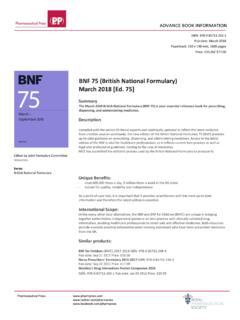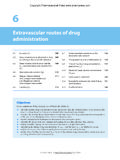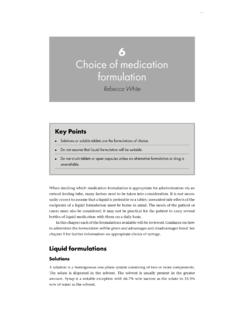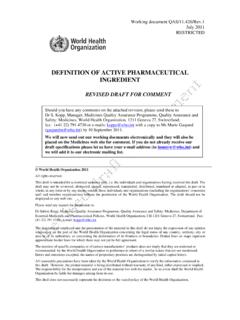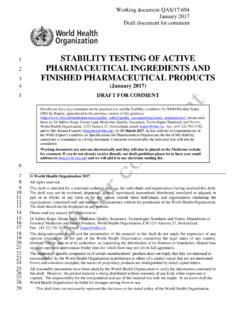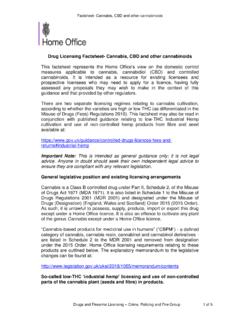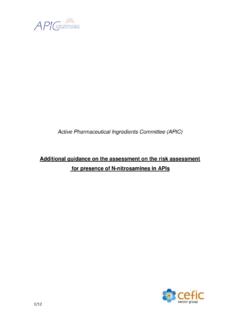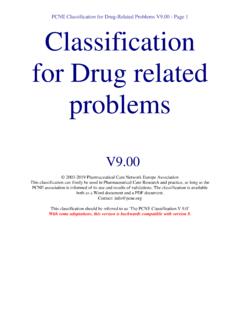Transcription of Pharmaceutical Compounding and Dispensing Sample Chapter
1 6 SolutionsIntroduction and overview101 General principles of solution preparation103 Solubility103 Stability103 General method103 Oral solutions104 Elixirs104 Linctuses105 Syrups105 Mixtures105 Draughts105 Spirits105 Paediatric drops105 Gargles and mouthwashes105 Enemas and douches105 External solutions105 Lotions105 Liniments105 Applications105 Collodions106 Worked examples106 Summary of essential principles relatingto solutions112 Packaging112 Discard dates112 Labelling113 Introduction and overviewSolutions are one of the oldest dosage forms used in thetreatment of patients and afford rapid and highabsorption of soluble medicinal products.
2 Therefore,the Compounding of solutions retains an importantplace in therapeutics today. Owing to the simplicityand hence the speed of preparation of an ad hoc for-mulation, they are of particular use for individualswho have difficulty in swallowing solid dosage forms(for example paediatric, geriatric, intensive care andpsychiatric patients), where compliance needs to bechecked on administration (for example in prisons orpsychiatric pharmacy) and in cases where precise, indi-vidualised dosages are a solution is a homogeneous liquidpreparation that contains one or more dissolved med-icaments. Since, by definition , active ingredients aredissolved within the vehicle, uniform doses by volumemay be obtained without any need to shake the for-mulation.
3 This is an advantage over some other for-mulation types ( suspensions, see Chapter 7).In general, water is chosen as the vehicle in whichmedicaments are dissolved, as it is non-toxic, non-irritant, tasteless, relatively cheap, and many drugsare water soluble. Problems may be encounteredwhere active drugs are not particularly water solubleor suffer from hydrolysis in aqueous solution. In thesecases it is often possible to formulate a vehicle contain-ing water mixed with a variety of other Chapter fromPharmaceutical Compounding and DispensingCopyright Pharmaceutical Press the British Pharmacopoeia (BP), oral solutionsare defined as Oral Liquids containing one or moreactive ingredients dissolved in a suitable vehicle.
4 Solutions provide a number of distinct advantagesand disadvantages compared with other dosage advantages of solutions as Pharmaceutical pro-ducts are that:*The drug is immediately available for solid dosage forms are taken orally, the drugneeds to dissolve before absorption into the bodycan take place. By providing the drug in a solution,the dissolution phase of the absorption process canbe bypassed, providing quicker absorption.*Flexible dosing is possible. The active ingredientwithin the solution will be present in a certainconcentration per unit volume. If alterations to thequantity of active ingredient to be administeredare required, a simple alteration to the quantity ofsolution to be taken is all that is required.
5 *They may be designed for any route of when discussing solutions the oral routeof administration is often considered, solutionscan be administered via a number of other preparations (injections), enemas forrectal use, topical (for use on the skin)preparations and ophthalmic preparations canall be solutions.*There is no need to shake the container. Unlikesome liquid preparations ( suspensions), as theactive ingredient is dissolved within the vehiclethere is no need to shake the container to ensure auniform dose is measured.*They facilitate swallowing in difficult cases. Somepatients may find it hard to swallow traditionalsolid dosage forms ( infants or the elderly).
6 Inthese situations, it may be easier for the patient totake a liquid dosage disadvantages of solutions as pharmaceuticalproducts are that:*Drug stability is often reduced in solution bysolvolysis, hydrolysis or oxidation. The stabilityof the active ingredient needs to be taken intoconsideration when formulating a solution. Forthis reason, it is common for solutions to attract ashorter expiry date than equivalent solid dosageforms.*It is difficult to mask unpleasant tastes. Althoughliquid dosage forms may be ideal for smallchildren who are unable to swallow solid dosageforms, many drugs taste unpleasant whenformulated into a solution.
7 It is possible to attemptto mask any unpleasant tastes by the addition of aflavouring, but this will not always be successful.*They are bulky, difficult to transport and prone tobreakages. A major disadvantage of all liquiddosage forms is that they are always much largerand more bulky than their comparable solidformulation. This makes them heavier and moredifficult to transport. Coupled with this is the factthat, traditionally, Pharmaceutical liquids arepacked in glass bottles. These are obviously proneto breakage which can be hazardous and cause theloss of the preparation.*Technical accuracy is needed to measure the doseon administration.
8 Although the dose can betitrated without the need to produce additionalpreparations (see point 2 from the advantagesabove), patient accuracy in measuring a dose isrequired. It is accepted that patients abilities tomeasure an accurate dose can vary considerablyand this needs to be taken into consideration whenpreparing a liquid preparation. This is especiallyimportant when the volume of liquid to beadministered is very small, where small changes inthe volume administered may result in largeincreases or decreases in dose.*Some drugs are poorly soluble. The solubility of adrug needs to be taken into consideration whenpreparing a solution to ensure that the finalvolume produced is not excessive.
9 In some cases itmay be necessary to alter the vehicle or drug form(for example the free alkaloid or its salt) in orderto be able to formulate a convenient preparation.*A measuring device is needed for not a major disadvantage, it must beborne in mind that a measuring device will need tobe supplied to the patient in order for them to beable to measure an accurate dose (this will havecost implications), and in addition the patient willneed counselling on the use of the advantages and disadvantages of solutions asdosage forms are summarised in Box | Pharmaceutical forms and their preparationSample Chapter fromPharmaceutical Compounding and DispensingCopyright Pharmaceutical Press principles of solutionpreparationHistorically, a range of solutions have been developed inorder to fulfil a wide variety of Pharmaceutical func-tions.
10 It is therefore common to find solutions classifiedaccording to their intended use ( oral internal, topi-cal, ophthalmic, nasal or parenteral), by the nature oftheir formulation ( simple or complex), or to becategorised by a traditional name that relates to thesolvent system used and/or their intended function ( , tinctures, aromatic waters, syrups and elixirs).Although the precise characteristics of differenttypes of solution may vary, the essential principlesgoverning their preparation remain similar. The twokey characteristics that need to be considered whencompounding solutions are solubility and following points relating to the solubility of thedrug element(s) of the formulation need to be takeninto consideration:*Will the drug(s) dissolve in the solvent or acomponent of the solvent system?





